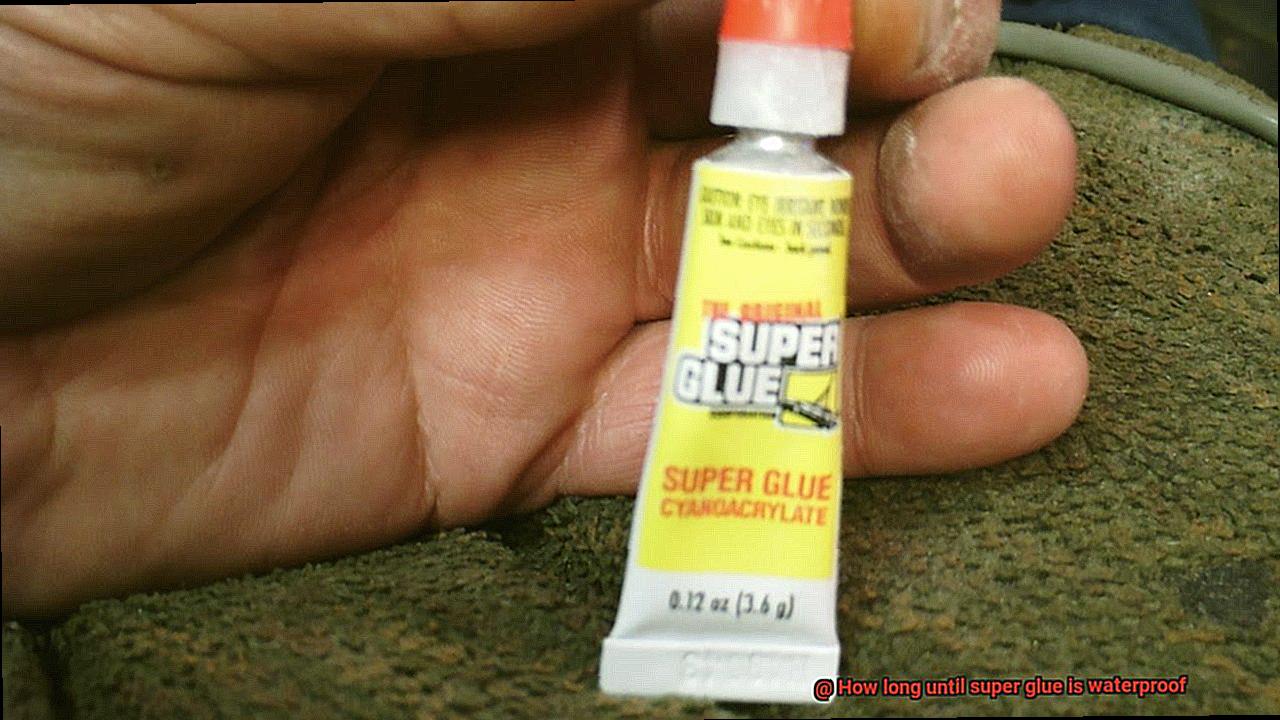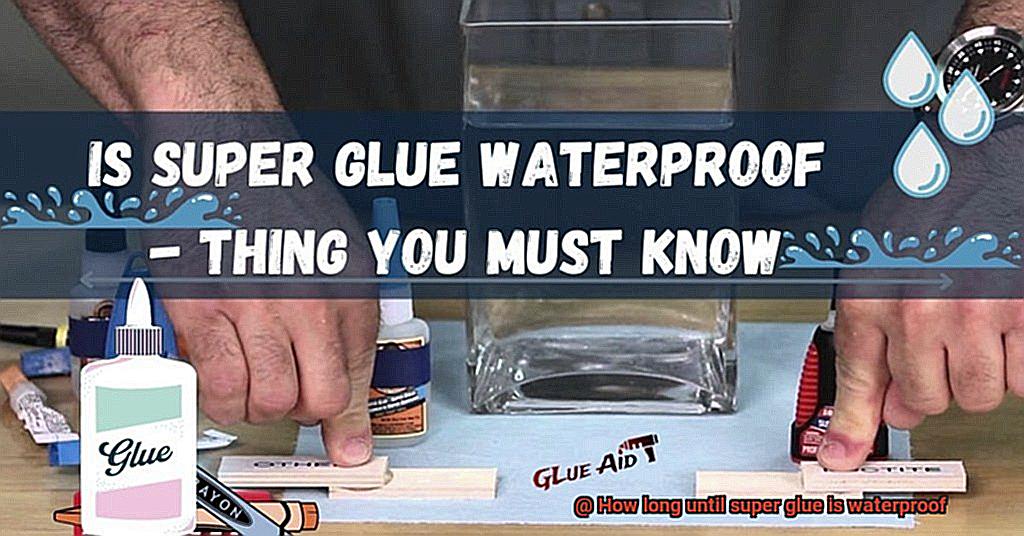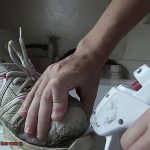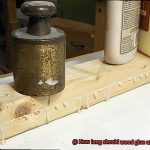Imagine this: you’re knee-deep in a DIY project, applying super glue to seal the deal. Suddenly, dark rain clouds roll in, and you start to wonder: how long until this glue becomes waterproof? Will a sudden downpour ruin all your hard work? Don’t fret, my fellow DIY enthusiasts. Today, we embark on a quest to uncover the truth behind this common conundrum.
Super glue, also known as cyanoacrylate adhesive, has become an essential tool for every household thanks to its unrivaled bonding strength. It forms an instant bond when exposed to moisture in the air, setting within seconds. But what about its resistance to water? That’s where things get interesting. We’ll dive into the factors that affect the waterproofing process and reveal just how long it takes for super glue to become impervious to water.
Join us as we explore industry insights, expert opinions, and scientific experiments to get down to the nitty-gritty of this intriguing question. Whether you’re a passionate DIY enthusiast or simply love unraveling everyday mysteries, this blog post will provide all the answers you crave.
So buckle up and let’s countdown together as we unveil the secret behind when super glue truly becomes waterproof.
Factors Influencing Super Glue Curing Time
Contents
- 1 Factors Influencing Super Glue Curing Time
- 2 Initial Drying Time of Super Glue
- 3 The Reaction of Super Glue with Moisture
- 4 Recommended Wait Time for Waterproof Bonding
- 5 Temperature and Humidity Impact on Curing Time
- 6 Long-Term Exposure to Water Weakening the Bond
- 7 Specialized Waterproof Adhesives for Underwater Applications
- 8 Conclusion
Super glue, also known as cyanoacrylate adhesive, is a remarkable adhesive with its swift drying and robust bonding properties. However, the curing time of super glue is subject to various factors that influence its efficiency. Allow me to delve into these factors in greater detail:
- Type of super glue: Different formulations exist for various super glues, and these variations impact the curing time. Some are designed to cure rapidly, while others require more time. It is essential to select the appropriate adhesive for your specific application.
- Temperature and humidity: The environment in which the super glue is applied plays a pivotal role in its curing time. Higher temperatures expedite the curing process, while lower temperatures slow it down. Correspondingly, high humidity levels accelerate curing, while low humidity prolongs it. Environmental factors must be taken into account when working with super glue.
- Bonding surfaces: The materials being bonded together can affect the curing time of super glue. Porous surfaces like wood or fabric tend to absorb the adhesive, thereby delaying the curing process. Conversely, smooth and non-porous surfaces such as glass or metal facilitate faster and more efficient curing.
- Bond thickness: The thickness of the bond line between the two surfaces being glued together influences the curing time. Thicker layers of super glue necessitate more time to penetrate and solidify, resulting in a lengthier curing process.
- Application technique: The manner in which super glue is applied also impacts its curing time. Applying a thin, even layer of adhesive ensures faster and more uniform curing compared to excessive amounts or uneven application.
- Quality and freshness of the glue: The quality and freshness of the super glue can affect its curing time as well. Older or expired glues may exhibit reduced effectiveness, resulting in longer curing times or weaker bonds. It is crucial to utilize fresh and high-quality glue for optimal results.
- Chemical accelerators: Certain super glues are designed to be used with chemical accelerators, which significantly expedite the curing process. These accelerators are typically applied to one surface before bonding, and they react with the adhesive to promote faster curing.
- Pressure applied during bonding: The application of pressure during the bonding process enhances the curing time of super glue. Pressure ensures maximum contact between the adhesive and the surfaces being bonded, facilitating faster curing.
By comprehending these factors, you gain better control over the curing time of super glue and achieve optimal results in various bonding applications. It is crucial to adhere to the manufacturer’s instructions and guidelines for the specific type of super glue being used to ensure proper curing and maximum bond strength.
Remember, while super glue can become waterproof once fully cured, it may not be suitable for long-term exposure to water or constant immersion. For stronger and more durable waterproof bonds, specialized waterproof adhesives are available that cater specifically to underwater applications or situations requiring high water resistance.
Initial Drying Time of Super Glue
The initial drying time of super glue, also known as cyanoacrylate adhesive, is a fascinating world filled with secrets and variables. To truly understand this process, we must delve into the depths of its nuances.
First and foremost, the type of super glue you choose can greatly impact its initial drying time. Different brands and formulas have unique characteristics, with some boasting lightning-fast curing abilities, while others take a more leisurely approach. So, be sure to select an adhesive that aligns with your specific needs.
Mother Nature also plays a pivotal role in the drying time of super glue. Temperature and humidity are like the weather gods, dictating how quickly or slowly the glue sets. Higher temperatures can accelerate the process, causing the adhesive to dry quicker than a sunbeam streaking across the sky. Conversely, lower temperatures can slow things down, transforming the glue into a chilled-out turtle. And let’s not forget about humidity – high levels can propel the drying time forward like an Olympic sprinter, while low levels put on the brakes like a cautious driver. So before you embark on your gluing adventure, consult the weather forecast for optimal results.
The surfaces you’re bonding together are also influential factors in drying time. Porous materials such as wood or fabric tend to absorb super glue, slowing down the curing process. On the flip side, smooth surfaces like glass or metal provide ideal conditions for speedy adhesion. So choose your materials wisely to ensure efficient bonding.
Thickness is another critical consideration. Thicker layers of super glue take longer to solidify and transform into waterproof superheroes. If you desire swift results, apply the glue thinly and evenly for a rapid transformation.
But application technique is where true finesse comes into play. Like a skilled underwater explorer, apply super glue with precision and delicacy. Spread it smoothly and evenly like butter on toast to facilitate quick and uniform curing. Too much or uneven application will leave you floundering in a sea of disappointment.
Quality and freshness also play significant roles in drying time. Old or expired glues may lose their powers, prolonging curing times or producing weaker bonds. Always opt for fresh, high-quality glue to ensure maximum effectiveness.
For those in need of immediate results, chemical accelerators can be your secret weapon. These magical potions, applied to one surface before bonding, work their alchemy by reacting with the adhesive, giving you lightning-fast results. It’s like giving your super glue a turbo boost.
And finally, the power of pressure should never be underestimated. Applying gentle pressure during bonding ensures maximum contact between surfaces, expediting the curing process faster than a speeding bullet train. So give it a gentle squeeze for superheroic results.
The Reaction of Super Glue with Moisture
Have you ever marveled at how super glue can create an unbreakable bond in a matter of seconds? The answer lies in its remarkable reaction with moisture. When super glue encounters moisture, a captivating chemical process called polymerization takes place, transforming the glue from a liquid into a solid adhesive. In this exploration, we will delve into the captivating world of super glue and its interaction with moisture.
- The Polymerization Process: As soon as super glue comes into contact with moisture, whether it be from the air, water droplets, or even perspiration, it sets off the polymerization process. This intricate process involves breaking down the chemical bonds within the glue, allowing the adhesive molecules to react and form crosslinks. These crosslinks hold the key to creating a bond that is robust and long-lasting.
- Time to Cure: The time required for super glue to become fully waterproof varies depending on several factors such as the type of glue, the amount of moisture present, and environmental conditions. Some super glues are engineered to cure rapidly in the presence of moisture, forming an unyielding bond within a few seconds. Others may necessitate exposure to air in order to fully cure, elongating the process before achieving complete waterproofing.
- Types of Super Glue: A diverse array of super glues is available on the market. Some are known as “water-activated” or “instant” adhesives, while others rely on air exposure for comprehensive curing. Adhering to the manufacturer’s instructions when using super glue is crucial to ensure proper curing and waterproofing.
- Environmental Factors: Temperature and humidity play significant roles in influencing the curing time of super glue. Higher temperatures generally expedite the process, while lower temperatures may impede it. Similarly, higher levels of humidity can hasten curing, whereas lower levels may protract it.
- Strength and Durability: Once super glue has fully cured and become waterproof, it forms an unyielding bond that is impervious to moisture. This renders it suitable for a myriad of applications, including repairing items that are exposed to water or outdoor conditions. However, it is important to note that specialized adhesives may be better suited for prolonged immersion in water or extreme conditions.
Recommended Wait Time for Waterproof Bonding
Well, worry no more. Super glue is here to save the day with its remarkable waterproof bonding capabilities. But how long do you need to wait before you can confidently take that repaired item out into the water? Let’s dive into the world of super glue and explore the recommended wait time for achieving a waterproof bond.
First and foremost, it’s important to understand that most super glues claim to dry and set within a matter of seconds or minutes. However, don’t be fooled by this initial drying time. While the surface may feel dry to the touch, the glue is still in the process of curing and strengthening its bond beneath.
To ensure a truly waterproof bond, it is generally recommended to wait at least 24 hours before exposing the bonded items to water or moisture. This gives the glue ample time to fully cure and create a durable seal. But remember, different brands of super glue may have slightly different recommendations, so always check the instructions provided by the manufacturer.
But what about those tricky situations where you’re bonding porous materials or large surface areas? Well, my friend, patience is key. Porous materials tend to absorb more moisture, which can affect the bonding process. In these instances, it may be wise to wait 48 hours or more before subjecting the bond to water. Trust me, it’ll be worth the wait.
Temperature and humidity also play a role in the drying and curing time of super glue. If you’re in a hurry and need that waterproof bond ASAP, higher temperatures and lower humidity levels are your friends. They facilitate faster drying and curing. On the other hand, if you’re dealing with chilly temperatures and high humidity levels, be prepared for a longer wait time.
Temperature and Humidity Impact on Curing Time
Today, let’s dive into the captivating world of super glue and unravel the mysteries behind its curing time. You may be curious about how temperature and humidity affect this process. Well, get ready for some enlightening information as we explore this fascinating topic.
First and foremost, let’s delve into what super glue truly is. Also known as cyanoacrylate adhesive, this mighty adhesive works its wonders through a mesmerizing process called polymerization. When super glue encounters moisture in the air, a chemical reaction takes place, creating robust bonds capable of withstanding incredible forces.
Now, let’s get to the heart of the matter – temperature and humidity. These two factors wield significant influence over the curing time of super glue. Imagine this: higher temperatures act as a turbo boost for the curing process. They accelerate it, ensuring a strong bond in no time. Conversely, lower temperatures put a damper on progress, slowing down the curing process. In fact, if it becomes too cold, the curing process might grind to a halt.
But hold on tight because there’s more. Humidity also plays a pivotal role in the curing time of super glue. Think of humidity as the lifeblood for the polymerization reaction. Higher humidity levels mean more moisture in the air, making it easier for super glue to work its magic and cure faster. However, if you find yourself in a desert region or any place with minimal humidity, patience becomes essential. In these dry conditions, it may take longer for your super glue to fully cure compared to more humid environments.
Now, if you’re pressed for time and need that waterproof bond ASAP (we’ve all been there), here’s a handy trick. Higher temperatures and lower humidity levels become your trusty sidekicks. They team up like superheroes on a mission, expediting the drying and curing process. So, when time is of the essence, strive to create an environment with higher temperatures and lower humidity to solidify that bond in record time.

Before we conclude, here’s a friendly reminder: extreme temperature or humidity conditions can have a detrimental impact on the quality and effectiveness of super glue. So, while patience is key, refrain from subjecting your glued items to extreme environments that could compromise the bond.
Long-Term Exposure to Water Weakening the Bond
Super glue, the hero of DIY mishaps, is celebrated for its rapid drying and unyielding bonds. But lurking in the shadows is a stealthy foe, ready to undermine our precious unions – water.
In this article, we’ll delve into the phenomenon of long-term water exposure weakening super glue bonds. We’ll explore the chemical reactions at play, examine practical solutions to prevent damage, and discover the factors that influence this process.
The Battle of Bonds:
Cyanoacrylate, the chemical bond that forms when super glue meets moisture in the air, is the foundation of its legendary strength. However, excessive water or prolonged exposure can infiltrate the microscopic gaps between bonded surfaces, unleashing havoc.
The Breakdown Process:
As water seeps into the bond, it accelerates the degradation of cyanoacrylate. This breakdown erodes the adhesive’s grip and gradually undermines its strength. The speed of this damage hinges on factors such as the super glue type and the materials being joined.
Examples and Solutions:
Imagine meticulously gluing a delicate porcelain figurine only to watch it lose its hold due to regular water cleaning. Picture a beautiful wooden sculpture loosening after being exposed to rain. Prevention is paramount in such scenarios.
To safeguard against water damage, consider these practical solutions:
- Avoid prolonged exposure: Keep bonded objects away from direct contact with water or damp environments whenever possible.
- Keep things dry: After brief water encounters, ensure thorough drying of bonded surfaces to preserve the integrity of the bond.
- Waterproof reinforcements: For anticipated frequent water exposure, employ additional waterproofing agents or sealants as an extra line of defense against infiltration.
- Specialized super glue variants: Seek out “waterproof” or “water-resistant” options specifically engineered to combat moisture-related issues.
Specialized Waterproof Adhesives for Underwater Applications
Today, we’re diving deep into the fascinating world of specialized waterproof adhesives for underwater applications. Whether you’re a marine engineer, a DIY enthusiast fixing your pool, or just someone curious about the wonders of glue, this article is for you. So, strap on your goggles and let’s explore the features and benefits of these adhesive marvels.
Creating Unbreakable Bonds:
Specialized waterproof adhesives are no ordinary glues. They are specifically formulated to conquer the challenges posed by water – from moisture to pressure and temperature variations.
These tough cookies can create strong and durable bonds even when submerged in water. Yes, you read that right. Their secret lies in a unique combination of synthetic polymers and additives that enhance their water resistance properties.
Versatility for Diverse Applications:
These adhesives aren’t just limited to one industry or application. They find homes in marine, construction, automotive, and electronics projects. In the marine industry alone, they are the go-to choice for bonding and sealing boat components like hulls, decks, and fittings. Talk about versatility.
Testing the Waters:
To ensure their performance in underwater environments, specialized waterproof adhesives undergo rigorous testing. These glues are subjected to tests that evaluate factors like bond strength, resistance to water pressure, durability over time, and compatibility with different materials. Rest assured, these glues have been put through the wringer and have come out stronger than ever.
Choosing the Right Adhesive:
Now that we know how amazing these adhesives are, it’s important to choose the right one for your specific needs. Some are designed for specific materials like metal or plastic while others offer versatility for bonding various substrates together. Make sure to follow the manufacturer’s instructions and prepare the surfaces properly for optimal bonding performance.
While specialized waterproof adhesives are masters at resisting water, they do have their limits. Factors like exposure to chemicals, temperature fluctuations, and mechanical stresses can affect their performance. So, it’s always wise to consider these variables and choose wisely.
h1tbjyd2qjA” >
Conclusion
Super glue, a beloved adhesive known for its strength and versatility, has one limitation – it’s not initially waterproof.
But fear not, as this remarkable substance undergoes a fascinating transformation over time. As the minutes tick by, the super glue gradually evolves into a water-resistant powerhouse, capable of withstanding even the most challenging aquatic conditions.
However, on average, you can expect super glue to become fully waterproof within 24 hours.






